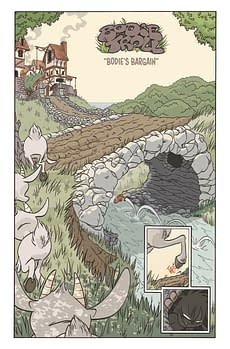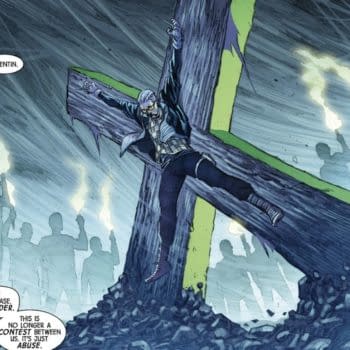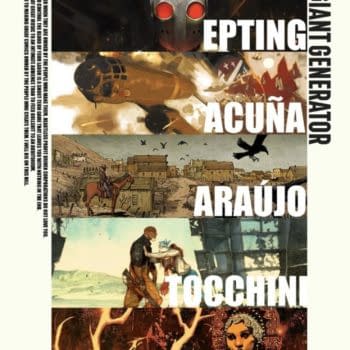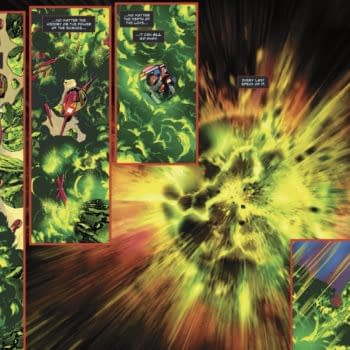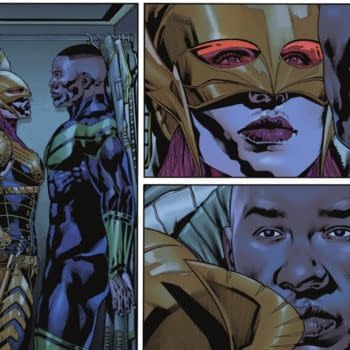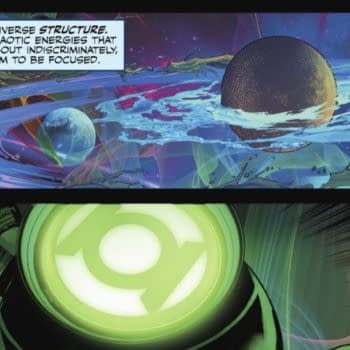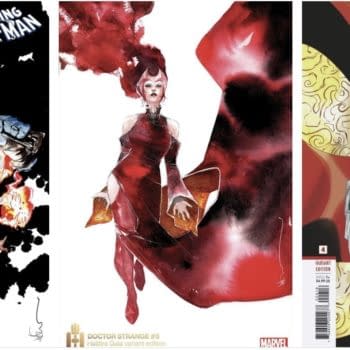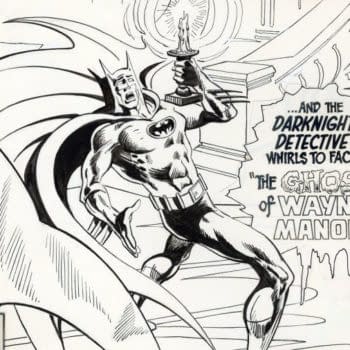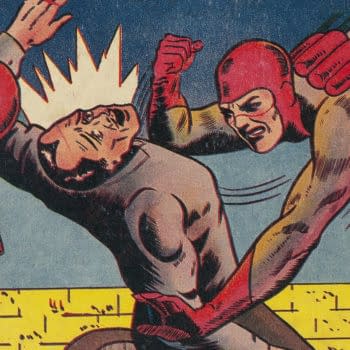Posted in: Comics | Tagged:
Talking To Jay Fosgitt About Popeye, Muppets And Dead Duck
Being an art collector, I'm always looking for new talent to commission and buy art from. I discovered Jay Fosgitt 's work thanks to Evan Shaner linking to one of his pieces a couple of years ago and ended up spending a lot of time browsing through Jay's online art gallery as a result. I ended up commissioning a few drawings from Jay, including one of Popeye and his supporting cast as a gift for my uncle, who is a huge Popeye fan. I also read all of Jay's comics that I could find, including the hilarious Dead Duck and Little Green Men. Jay is both a gifted writer and artist, along with being a really friendly guy, and I am a fan for life now. Jay has a new series, Bodie Troll, up for preorder this month, and so I thought that now was a great time for everyone to learn all about Jay.
Okay, Jay, let's start off with a question that I ask everyone: how did you get into comics?
I think it began as a natural extension of my art. I started drawing at age two, and I guess I showed an aptitude for it pretty soon thereafter. I grew up in a fairly rural town that didn't have any sort of artistic community, so there wasn't much to inspire me creatively. But I was surrounded by cartoons, from newspaper comics to TV cartoons to comic books. Those outlets stimulated my creativity, and I was hooked. On another level, though, I feel like even if I didn't have those outlets, I inevitably would have been drawn to cartoons. It was in my blood from day one.

Around the time I was in the third grade, I was betrothed a stack of old superhero comic books from my cousin's collection–dog eared and torn copies of "Spider-Man", "Fantastic Four" and "The Incredible Hulk". The storytelling was like nothing I'd experienced with newspaper comics–these stories were far more expansive, character driven and action packed. That hooked me immediately. The art was something else entirely–I was curiously attracted to the illustrative/cartoony hybrid art styles found in these comics, and it inspired me to stretch my art beyond the four panels of the newspaper page.
A year into my comic book fandom, a local comic shop–Coy's Comics–opened up. From the moment I saw the huge green Incredible Hulk on the store's banner, I was totally hooked. Coy's became my mecca of comic book collecting from age nine onward. Because I was into the history of comic books, I was a rabid fan of books like "Marvel Tales" and "Marvel Saga" which reprinted classic stories and moments from Marvel's long publication history. Not surprisingly, I also gravitated to the weird, funny and cartoony, so my favorite books were "Groo the Wanderer", "Flaming Carrot", "Howard the Duck", "Boris the Bear" and "'Mazing Man". Those books had the biggest influence on who I became as a professional cartoonist.

I knew that you were a Muppets fan based on some of the Muppet drawings I've seen you post and I remember you pitching a Muppets series to Boom! Studios at one point. I know that I used to watch the original Muppet Show with my dad when I was a kid and then later watched Muppet Babies every weekend with my step-brothers. When someone recorded Labyrinth onto a VHS tape for me I must have watched it at least a hundred times. All of Jim Henson's works seemed to really capture my imagination. I also really enjoyed the 2011 Muppets movie and Roger Landridge's Muppets comics from a couple of years ago. Anyway, tell me about your humongous Muppet fandom.


As I said in an earlier question, I believe cartooning was in my blood, and I felt I was somehow born into it, though no one else in my family had the talent or desire. Because I started drawing at age two, I had plenty of time to discover my artistic calling. But it actually just took me three years to realize it. At age five, I pronounced to anyone who would listen that I was going to be a cartoonist when I grew up. I never lost sight of my goal, winning school awards for my artwork, making my first professional sale at age thirteen (designing a t-shirt logo with a mosquito mascot on it), and breaking in as a party caricaturist by my high school years. After high school, I made a name for myself as the staff cartoonist on a handful of college newspapers. Working on those college papers was the best education I received in my art. I learned layout, production, writing, editing, and got my earliest lessons in Photoshop, which served me well in later years. Almost all my training in Photoshop came from hands on experience on the school papers, since I never took any classes in it. I've always been a pen and paper cartoonist, but learning the ins and outs of digital coloring was an evolutionary leap for my artistic skill set. Another artistic outlet for me had been theater. I performed in plays in high school and community theater, and decided theater would make a good minor for me in college. Being on stage and taking theater classes in college helped my education in cartooning, as I learned staging and acting techniques that I would bring to my comics and characters. I believe that to be a good cartoonist, you need to be a good actor. As such, studying theater was a real asset to my art. I did take my share of standard art courses in college, and studying painting, life drawing and figure drawing certainly brought something to my artistic abilities. But it was the practical lessons I learned on stage and in the newsroom that I hold most dear to this day.
I've heard others say that acting has helped with their art as well, so maybe taking an acting class or two should be recommended to future comic artists? Food for thought. Anyway, we know Jim Henson was one, but tell us about more of your artistic influences, both inside and outside of comics.
My creative influences come from many different artistic genres.
I'm influenced by animators like Chuck Jones (director of countless Loony Tunes shorts and "The Grinch Who Stole Christmas"), Ralph Bakshi (director of such groundbreaking animated films as "Heavy Traffic", "Coonskin" and "Wizards"), Chris Sanders (director, writer and actor of "Lilo and Stitch" and "How To Train Your Dragon"), Don Bluth (director of such films as "Secret if Nimh" and "Rockadoodle"), Richard Williams (director of the films "The Thief and the Cobbler", and "Raggedy Ann and Andy", and animation director of "Who Framed Roger Rabbit"), Bill Plympton (director of the films "I Married A Strange Person" and "Hair High"), John Korty (director of the animated film "Twice Upon A Time"), Clive Smith (director of "The Devil and Daniel Mouse" and "Rock & Rule") Eric Goldberg (animator of the genie in "Aladdin"), The Fleischer Brothers ("Betty Boop") and Bill Melendez (director of the "Peanuts" holiday specials and feature films).

From childrens books, I'm influenced by illustrators Shel Silverstein ("Where the Sidewalk Ends"), Maurice Sendak ("Where the Wild Things Are"), David Catrow (illustrator of "The Boy Who Looked Like Abe Lincoln"), Dr. Seuss ("The Cat in the Hat"), and Frank Cammuso ("Knights of the Lunch Table").
Other illustrators who have influenced me have been Al Hirschfeld (the great theatrical caricaturist), and Brian Froud (co-author of the book "Faeries").
The writers who influence me the most are Neil Gaiman ("American Gods"), Joss Whedon (creator of the tv series "Firefly") Ray Bradbury ("Something Wicked This Way Comes"), Paul Malmont ("The Chinatown Death Cloud Peril"), Harper Lee ("To Kill a Mockingbird"), Mario Puzo ("The Godfather"), L. Frank Baum ("The Wonderful Wizard of Oz"), and J.K. Rowling (the "Harry Potter" series).

Actors who have influenced me have been Bill Irwin, Robin Williams, John Belushi, Zach Braff, Alan Tudyk, John C. McGinley, Nathan Lane, Frank Welker, Maurice LeMarch, Jim Cummings, each member of "The Kids in the Hall", Billie Hayes, Patrick McKenna, Jim Dale, Bill Murray, The Marx Brothers and Paul Reubens.
Artists from the field of special effects and make-up who influenced me most are Rick Baker, Rob Bottin, Stan Winston, Todd Masters, and Kevin Yagher, and the artists behind KNB Efx and Spectral Motion.
And some musicians who have influenced me are The Beatles, The Who, Queen, Creedence Clearwater Revival, Journey, Carole King, Abba, Electric Light Orchestra, Chicago, The Commitments, David Bowie, Pink Floyd, Led Zepplin, Crosby Stills Nash and Young, The Guess Who, Gerry Rafferty, Sting, and Billy Joel.
Wow, that's a lot of influences. And a good variety. Okay, continuing along, the first comic I read from you was the Dead Duck graphic novel. I remember the book being very funny, but also how you'd put in occasional hints at the dark and serious nature of what exactly Dead Duck is. So for those unfamiliar with the comic, tell us all about Dead Duck.
The general synopsis I always use is: Dead Duck is a minion of Death who delivers the recently deceased for his boss, J.P. Yorick, with the assistance of his sidekick, Zombie Chick. More specifically, Dead Duck was a character I created when I was fourteen. I spent the better part of twenty years developing him and his supporting characters, until 2006 when I felt the time was right to create a graphic novel around his adventures. The book was published by Ape Entertainment, and was heavily influenced by the underground comics of the 60's and 70's, particularly those created by Vaughn Bode and The Air Pirates. Though "Dead Duck" was meant to be a humor book, I wanted there to be elements of horror and pathos in the book as well. It was a unique stew of ideas and influences, and did pretty well, selling out it's initial print run to become (at the time) the most successful creator owned book Ape Entertainment had published.
Over a year ago you started putting Dead Duck online for free (read it here, folks!), which was a very cool move, in my opinion. What made you decide to do that, and have you gained new fans because of it?
On Halloween 2011, I began reprinting all my previously published "Dead Duck" stories as web comic installments. The idea was to introduce Dead Duck to wider audience through the internet, while at the same time create new stories and eventually have enough material for a follow up graphic novel. About six months into the web comic, I began developing a new all-ages comic called "Bodie Troll". Ideas for "Bodie" started sparking in me so rapidly that I put aside my plans for "Dead Duck" and shifted my creative efforts towards "Bodie". It paid off, as I took some "Bodie" samples with me to San Diego Comic Con in 2012, met the publishers of Red 5 Comics, and signed with them to carry "Bodie Troll" as a regular comic book series starting April 2013. "Dead Duck" is still online, and there are three never-before-seen stories that I created during the web comic's run which I'll be posting in the coming months. After that, "Dead Duck" is going on hiatus while I continue work on "Bodie Troll".
We'll get back to Bodie Troll soon, but first let's talk about my favorite tiny alien invader comic, Little Green Men. How did that series come about and are there plans for more books?
Right after my "Dead Duck" graphic novel was released through Ape Entertainment, the publishers came to me with a new comic idea. The envisioned a trio of aliens loosely based on The Three Stooges that come to Earth to invade it, but who discover that Earthlings are towering giants compared to them. The publishers had already decided what the aliens would look like, having previously hired another artist to draw up a test page. I had a free hand to reinterpret those designs though my own style. I was given the aliens names (Lartee, Moke and Gerlex) and the title "Little Green Men" by the publishers, and from there I was allowed to just run with it and come up with everything else on my own. I had a blast coming up with silly names for everything, like their ship, The Nuknuk 4000 (a nod to Curly's "nyuk nyuk" laugh from The Three Stooges) and The Planet Blarf, which I chose because it sounded like 'barf", which seemed funny. I wrote and drew three volumes of "Little Green Men", but by the time the third book was wrapping up, the publishers at Ape had a couple other comic ideas they wanted me to develop for them. So they decided to cease production on "Little Green Men". I kind of doubt we'll see any more volumes down the road, but I'm happy I had the chance to create the ones I did.
One comic you draw regularly is Necronomicomics. Tell us a little about that.
Necronomicomics is a single panel cartoon that I draw for Rue Morgue Magazine, in which I lampoon classic horror films. I've been drawing the monthly cartoon for going on three years now. As a big fan of horror movies, it's been kind of a dream gig, and I've had no shortage of material to inspire my most macabre gags. I hope to release a collection of "Necronomicomics" sometime next year and take it around to some horror cons.
Well let's move on to your work process. How do you go about creating your comics? Do you write an outline first or loosely plot the story in your head and then start drawing or what exactly do you do?
With my creator owned comics, I have a notebook that I jot down story ideas in. I do this is a rapid fire, 'stream of consciousnesses' writing style that eschews paragraphs in favor of pages-long blocks of scribbly handwriting, fragmented sentences and bad grammar. It's that moment of desperation where an idea hits me so hot and hard that I need to get it all out right then and there, not unlike throwing up, but in a good way. If my notebook isn't handy and it's just a matter of capturing a shred of an idea, blank sides of restaurant place mats, old receipts and long forgotten business cards have done in a pinch. I'll take these mangled notes and transform them into a more concise script, typing it out in Microsoft Office, and doing my best to retain all the key elements of my previous scribbles. No matter how well these first two steps in the writing process go, however, it's inevitable that I'll change up some dialogue or even add an extra gag or two as I letter a comic page. I find that you can't plan your best work, and it typically waits to show itself when you're committing to the finished page. Similar to my notebook, I have a couple small sketchbooks that I try to keep on hand for jotting down character and environment designs. Sometimes those sketches will get used for an intended project and sometimes they don't. But I hold onto those doodles, and inevitably, they'll pop up in some other project later down the road. Just as often, I won't do any pre-design work, and I rarely do thumbnails in advance of a final drawing. That's a lot of fun in itself, and taps into my background in improv theater, where spur of the moment creativity is key. It also cuts down a bit on production time, which is nice. An exception to this rule is when I know I need a story to be a certain page length. In that case, I'll block out my script, determining that certain chunks of action and dialogue need to go on specific pages to reach the predetermined page count. But even in that case, I have no advance idea about how the panels will be laid out, nor how backgrounds or characters will be drawn. It keeps things fresh and spontaneous for me, and kind of allows me to be my own audience, seeing it unfold as it comes.
I draw at a drafting table with a top that can raise to a 130 degree angle, and use a t-square, ruler and triangle for drawing panels and straight lines. I pencil my comic pages on 11X17 sheets of smooth Bristol board, using a soft lead mechanical pencil, and keeping a white plastic eraser nearby for inevitable fixes. I ink my work with a variety of pens: Faber Castell Pitt artist pens (extra small, small, fine, medium and brush tips), Kuretake and Zebra brush pens, and a Kuretake Vellum Writer to draw my panel borders and for thick lettering. After inking my pages and erasing any exposed penciling, I scan in my pages on an 11X17 scanning bed, open them up in Photoshop, and clean up my pages of any of my errors or "schmutz" picked up from the scanning process. I color everything digitally, saving three different versions of each page as line art (just the black and white artwork), unflattened pages (unlocked layers of line art, coloring and assorted details), and finished pages (all the elements locked into a single layer). Every version of the art is saved as a TIFF. I'll then upload the pages to my publisher's server. The only difference in my process from drawing my creator-owned stuff to doing other people's properties is having to show some of my steps along the way to the publishers. In most cases, it's strictly a formality, and my work typically sees print the way I originally wrote and drew it. On the rare occasion where a change is required, Photoshop is extremely helpful, and makes any changes easier and quicker than would otherwise have been the case. A whole other situation can occur with my single panel cartoon, "Necronomicomics", which is published in Rue Morgue Magazine. While it's my creation, and I write and draw the comic with no editorial input, Rue Morgue reserves the right to reject a cartoon. In three years of drawing this cartoon, there have only been two rejections. In each case, I was fortunate in that I draw my cartoons far in advance, and stockpile them so that I always have at least six months worth of cartoons on standby at any given time. In that way, replacing a rejected cartoon with a fresh one is a breeze.
Are there any characters, besides your own, that you'd like to work on one day?
I would still like to work on comics featuring The Muppets. I came so close when they were with Boom, and had they not lost the license to Marvel, it would have happened. I'm still wide open to the possibility. I'd love to work on IDW's Popeye comic book. I'm a HUMONGOUS Popeye fan, and that would be a dream come true. I'm also a big fan of the old Rocky and Bullwinkle cartoon, and if a publisher decided to dust off that property and turn it into a comic, I'd jump on the first plane to Mooseylvania for a chance to work on the book. I'd also like a chance to revive some long canceled properties that were my favorites from my childhood. For example, if Marvel decided to bring back Spider-Ham and do it right (I haven't been a big fan of some of their recent attempts), I could write and draw the hell out of that comic. And I'd love a chance to write and draw a revival of DC Comics' 'Mazing Man comic.
Well, I do love your take on Popeye, and think you'd be excellent on Spider-Ham and/or 'Mazing Man. Maybe someday. Now, tell me what was the last really comic book your read?
The last really great comic I read was "Jim Henson's Tale of Sand", by Ramon K. Perez. I suppose being a Henson fan, I was determined to like it on some level no matter what. But I hadn't foreseen that I would totally LOVE it. It's the greatest graphic novel I've read since I first experienced Watchmen when I was fifteen. Jim Henson and Jerry Jules' long lost script is a brilliant pastiche of absurdist storytelling, with equal parts suspense, pathos and humor. And though there are no characters with obvious Muppet connections, somehow Jim's creativity shines like a beacon throughout the story. And Perez's visual storytelling is breathtaking. His staging, characters and environments make me think of George Herriman's classic "Krazy Kat" comic strip if it were drawn by Roy Crane. I derived more enjoyment and inspiration from this book than any other comic I've read in a good long while.
I can't disagree with you there. I read Tale of Sand last year and was blown away by the visuals. I'm not sure how it would work as a movie, but Ramón Pérez definitely made it seem like it was destined to be a comic. Finally, let's talk about Bodie Troll, which is up for preorder this month from Red 5 Comics.
In the fairytale village of Hagadorn lurks Bodie Troll, a fuzzy little grump who wants to be big and scary, but is doomed to be cute and cuddly, and no help from his Fairy Godmother-employer, Miz Bijou, or his barmaid-best friend, Cholly, can change that. But what Bodie lacks in terror he makes up for in mischief, and silly and suspenseful adventures await just beyond his bridge. Fans of such classic works as Jay Ward's "Fractured Fairy Tales", Jim Henson's "Muppets", and Maurice Sendak's "Where the Wild Things Are" will feel at home in the wild, warm and whimsical romp of Bodie's adventures. "Bodie Troll" is my creator-owned all ages comic that's being released through Red 5 Comics, publishers of the Eisner-nominated "Atomic Robo". It's currently available for pre-order through Diamond (order code FEB131119), with a release date of April 17th, 2013.
Read more about Jay at his website at http://jayfosgitt.com/, follow him on Twitter at http://twitter.com/JayPFosgitt


